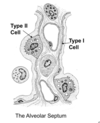1 - Respiratory System Histology Flashcards
What is respiration?
Breathing
Gas exchange: air > blood
Gas transport
Gas exchange: blood > tissue
Cellular respiration
Name these anatomic components of the respiratory system


Clinically, the respiratory system can be divided into what? What can it be divided into functionally?
Clinically: upper and lower portions. The upper portion is above the oropharynx, the lower is below the oropharynx.
Functionally: conducting portion and the respiratory portion;

What anatomical parts are part of the conducting portion of the respiratory system and what function do they serve? What lines this passageway?
Nose, pharynx, larynx, trachea, bronchi, bronchiles, terminal bronchioles.
Delivers clean, warm, moist air to respiratory passageways. Have wall stabilized by bone, cartilage, or muscle.
Lined by mucosa and produce seromucous secretions. Lined with respiratory epithelium.

What anatomical parts are part of the respiratory portion of the respiratory system and what function do they serve?
Respiratory bronchioles, alveolar ducts, alveolar sacs, alveoli.
Site of exchange of O2 and CO2 between blodo and alveoli.

What are the respiratory passageways lined with? What is the function of this?
The lining membrane of cavaties (eg lumens of tubular organs) that have a connection to the exterior of the body is called a mucosa.
Mucosa provides:
- immunological and physical barrier
- a source of secretory products
- a selective absorptive interface
What are the two consistent components of a mucosa?
Epithelium at the surface
Lamina propria - a connective tissue layer that supports the epithelium

Describe the epithelium and lamina propria of the nasal mucosa? How does this differ from the nostrils and nasal vestibule?
Epithelium: ciliated pseudostratified columnar with goblet cells
Lamina propria: seromucous glands and venous plexus
The nostrils and nasal vestibule have stratified squamous epithelium, which is better for handling stress.
How are particulates removed from mucous in our bodies?
Glands and cilia interact to expell particulates. Mucus traps it and cilia gets it out of the way to be swallowed or coughed up
Called the mucociliary escalator.
Most particulates can be cleared within 24-48 hours within this mechanism.

What cell types are found within the respiratory epithelium?
- Columnar cells
- Goblet cells
- Basal cells
- Small granule cells
- Brush cells

What cells are located within the olfactory epithelium?
- Olfactory cells
- Supporting cells (sustentacular cells)
- Basal cells
- Brush cells
Olfactory epithelium do NOT have goblet cells and instead have olfactory (oder sensing) nerve cells.

What are olfactory cells and what is their function?
Bipolar neurons, apical dendrite ends in olfactory vesicle from which non-motile cilia with receptors for odiferous substances arise.
When a threshold level of receptors are occupied, an AP is generated and transmitted to the olfactory bulb via axon which passes through cribiform plate to synapse in the olfactory bulb.

What are sustentacular cells of the olfactory epithelium and what is their function?
Tall columnar cells with microvilli. Provide physical support, nourishment and eletrical insulation for olfactory cells.

What are basal cells and bowmans glands of the olfactory epithelium?
Basal cells: stem cells to replace olfactory and sustentacular cells
Bowman’s glands: provide serous fluid to refresh olfactory cilia

In the nasopharyn, there’s lymphoid tissue relating to what structures?
The adenoids

What are the components of the larynx?
Epiglottis. Lingual surface has stratified squamous epithelium. On pharyngeal surface is respiratory epithelium.
As you move down towards false vocal cords - resp epithelium
True vocal cords - stratified squamous epithelium. On these you have vocal ligament and vocalis muscle

What are the components of the trachea?
Mucosa lined with respiratory epithelium which continuously propels mucus and debris towards the larynx.
Seromucus glands in the submucosa help produce mucus sheets.
16-20 C-chaped rings of hyaline cartilage prevent the trachea from collapsing. Closed posteriorly by the trachalise (smooth) muscle.
What are the divisions of the bronchi? What are the components of the bronchi?
Primary bronchi enter the lung where they subdivide into secondary and tertiary bronchi.
Mucosa and submucosa similar to trachea.
Smooth muscle.
Plates of hyaline cartilage encircle bronchus and prevent collapse.

What do the bronchi divide into? What structures do they lead to?
Bronchus with cartilage and smooth muscle in wall divides into bronchioles with no cartilage, just smooth muscle in wall.
Terminal bronchioles
Respiratory bronchiles
Alveoli surrounded by fine elastic fibers
Alveolar capillary network

What type of cells line the bronchioles? What is their function?
Club (bronchiolar) cells: columnar cells with domed shape apices and short, blunt microvilli.
Apical cytoplasm filled with secretory granules containing surfactant-like material that reduces surface tension and facilitates patency of bronchioles.
Cells also degrade inhaled toxins.

How do the cell types change as the bronchiole becomes smaller? What function does this serve?
Epithelium has fewer goblet cells.
Terminal bronchioles are lined with simple cuboidal epithelium.
Proportion of smooth muscle cells increases, allowing for constriction (parasympathetics) and dilation (sympathetics) of airways.

What are three clinical conditions that affect intrapulmonary conducting airways?
Chronic bronchitis - damage to mucosa, hypertrophy, and build up of mucus
Cystic fibrosis - inability to clear mucus
Bronchial carcinoma - can originate from squamous metaplasia or neuroendocrine cells in the epithelium

What is cystic fibrosis?
Water in the lungs is salty from chloride channels, this pump is missing or broken in CF and thus the water layer lacks salt and the mucous layer crushes the cilia and mucous cannot be cleared from the airways.
What happens to the respiratory system in asthma?
Continuous constriction of the conducting passageways and a build up of mucous causing inability to breathe properly










